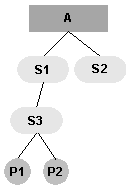| Mates move to the Mates folder of the lowest common
parent. |
For example, assume that there is a
mate between P1 and P2, in the Mates folder of the nested subassembly S3.

- If you move P1 up one level (into S1), the mate moves to the
Mates folder of
S1, the lowest common
parent on the same branch.
- If you move P1 into S2 (a different branch), the mate moves to the
Mates folder of the
top-level assembly A,
because A is the only
common parent.
- If you dissolve S3, the mate moves to the Mates folder of subassembly
S1.
|
| Component patterns have specific
limitations. |
- If you move the seed component of a pattern into
a different assembly, the pattern feature and all the instances
generated by the pattern are deleted.
- You cannot move individual instances generated
by the pattern.
|
| Assembly feature cuts and holes might
be deleted. |
Assembly feature cuts and holes are
deleted when you move subassemblies up a level in the FeatureManager
design tree. When you form and dissolve
subassemblies, assembly feature cuts and holes are not
deleted.
|
| Equations may not be solved. |
This is because, in many cases, the
instance number suffix <n> of
the components changes when you reorganize or dissolve an assembly. This
is done automatically, to prevent conflicts with existing components in
the destination assembly. |
| The reorganized component is removed
from any explode steps where it appears. |
|
| Routing subassemblies are subject to
some special rules. |
See Editing a Route Subassembly for more information. |